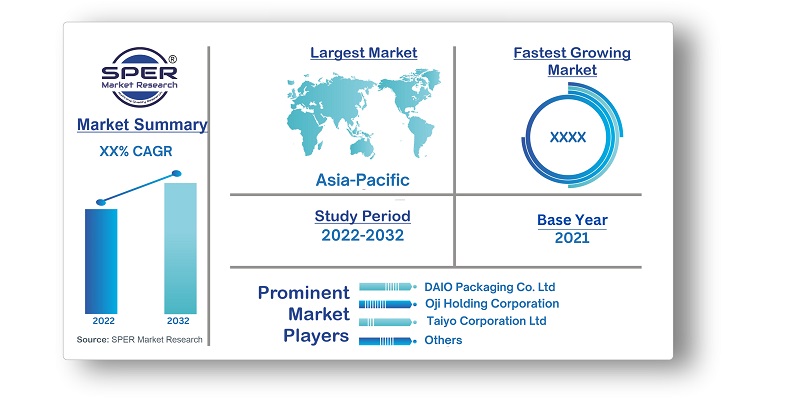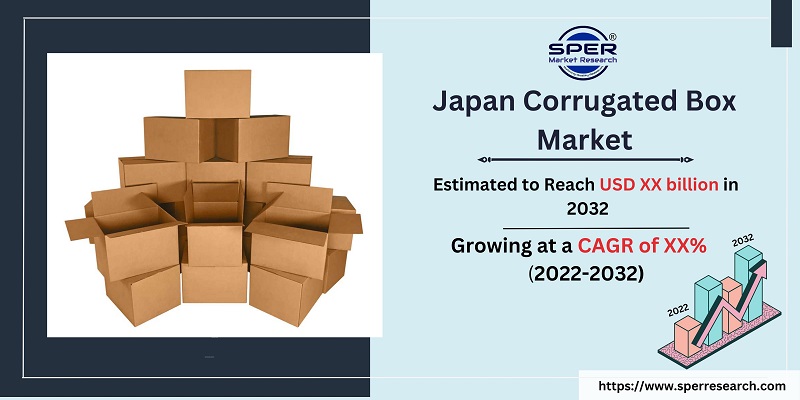
Japan Corrugated Box Market Growth, Size, Share Revenue, Key Manufacturers and Future Outlook
Japan Corrugated Box Market Size- By Type of Box, By End Users, By Type of Flute- Regional Outlook, Competitive Strategies and Segment Forecast to 2032
| Published: Mar-2023 | Report ID: PACK2309 | Pages: 1 - 105 | Formats*: |
| Category : Packaging | |||


| Report Metric | Details |
| Market size available for years | 2019-2032 |
| Base year considered | 2021 |
| Forecast period | 2022-2032 |
| Segments covered | By Type of Box, By End Users, By Type of Flute. |
| Regions covered | Chubu, Kanto, Kinki, Okinawa, Others. |
| Companies Covered | Aichi Corrugated Cardboard Co. Ltd., Chuoh Pack Industry Co. Ltd., Dainippon Pax Kyoto Corporation, DAIO Packaging Co. Ltd, Dynapac Corporation, Hiradan Corporation, Itoh Corrugated Industrial Co. Ltd., Kariya Shiki Co. Ltd., Ltd. (Hako Hira Cardboard Kabushikiisha), Maruichi Corporation, Misuzu-Shigyou Inc., Oji Holding Corporation, Rengo Co. Ltd, Ryohei Corrugated Co., Taiyo Corporation Ltd., Tokai Paper Co. Ltd., Tomoku Co. Ltd., Yamakoh Co. Ltd. |
- Manufacturers and producers.
- Distributors and retailers who require packaging solutions.
- Packaging design and manufacturing companies.
- Logistics and shipping companies.
- Government agencies.
- Environmental organizations.
- E-commerce businesses.
- Small and medium-sized enterprises (SMEs).
- Export-oriented businesses.
- Packaging consultants.
- Slotted
- Die-Cut
- Processed Food
- Fruits & Vegetables
- Electrical Appliances and Machinery
- Pharmaceuticals
- Detergents & Cosmetics
- Ceramics
- Glassware & Sundries
- Mail Order
- Parcel Delivery & Moving
- Other Foods
- Textile Products
- Single
- Double
- Triple
- Chubu
- Kanto
- Kinki
- Okinawa
- Japan Corrugated Box Market Size (FY’2019-FY’2032)
- Overview of Japan Corrugated Box Market
- Segmentation of Japan Corrugated Box Market By Type of Box (Slotted, Die-Cut, Others)
- Segmentation of Japan Corrugated Box Market By End Users (Processed Food, Fruits & Vegetables, Electrical Appliances and Machinery, Pharmaceuticals, Detergents & Cosmetics, Ceramics, Glassware & Sundries, Mail Order, Parcel Delivery & Moving, Other Foods, Textile Products, Others)
- Segmentation of Japan Corrugated Box Market By Type of Flute (Single, Double, Triple)
- Growth Analysis of Japan Corrugated Box Market
- Problems and Challenges in Japan Corrugated Box Market
- Competitive Landscape in the Japan Corrugated Box Market
- Impact of COVID-19 and Demonetization on Japan Corrugated Box Market
- Details on Recent Investment in Japan Corrugated Box Market
- Competitive Analysis of Japan Corrugated Box Market
- Key Players in the Japan Corrugated Box Market
- Japan Corrugated Box Market Future Outlook and Projections (FY’2019-FY’2032)
- Recommendations from Analyst
1.1. Scope of the report1.2. Market segment analysis
2.1 Research data source2.1.1 Secondary data2.1.2 Primary data2.1.3 SPER’s internal database2.1.4 Premium insight from KOL’s2.2 Market size estimation2.2.1 Top-down and Bottom-up approach2.3 Data triangulation
4.1. Driver, Restraint, Opportunity and Challenges analysis4.1.1 Drivers4.1.2 Restraints4.1.3 Opportunities4.1.4 Challenges4.2. COVID-19 Impacts of the Japan Corrugated Box Market
5.1. SWOT analysis5.1.1 Strengths5.1.2 Weaknesses5.1.3 Opportunities5.1.4 Threats5.2. PESTEL analysis5.2.1 Political landscape5.2.2 Economic landscape5.2.3 Social landscape5.2.4 Technological landscape5.2.5 Environmental landscape5.2.6 Legal landscape5.3. PORTER’S five forces analysis5.3.1 Bargaining power of suppliers5.3.2 Bargaining power of Buyers5.3.3 Threat of Substitute5.3.4 Threat of new entrant5.3.5 Competitive rivalry5.4. Heat map analysis
6.1 Japan Corrugated Box Manufacturing Base Distribution, Sales Area, Product Type6.2 Mergers & Acquisitions, Partnerships, Product Launch, and Collaboration in Japan Corrugated Box Market
7.1 Slotted7.2 Die-Cut7.3 Others
8.1 Processed Food8.2 Fruits & Vegetables8.3 Electrical Appliances and Machinery8.4 Pharmaceuticals8.5 Detergents & Cosmetics8.6 Ceramics8.7 Glassware & Sundries8.8 Mail Order8.9 Parcel Delivery & Moving8.10 Other Foods8.11 Textile Products8.12 Others
9.1 Single9.2 Double9.3 Triple
10.1 Japan Corrugated Box Size and Market Share by Region (2019-2025)10.2 Japan Corrugated Box Size and Market Share by Region (2026-2032)10.3 Chubu10.4 Kanto10.5 Kinki10.6 Okinawa10.7 Others
11.1 Aichi Corrugated Cardboard Co. Ltd.11.1.1 Company details11.1.2 Financial outlook11.1.3 Product summary11.1.4 Recent developments11.2 Chuoh Pack Industry Co. Ltd.11.2.1 Company details11.2.2 Financial outlook11.2.3 Product summary11.2.4 Recent developments11.3 Dainippon Pax Kyoto Corporation11.3.1 Company details11.3.2 Financial outlook11.3.3 Product summary11.3.4 Recent developments11.4 DAIO Packaging Co. Ltd11.4.1 Company details11.4.2 Financial outlook11.4.3 Product summary11.4.4 Recent developments11.5 Dynapac Corporation11.5.1 Company details11.5.2 Financial outlook11.5.3 Product summary11.5.4 Recent developments11.6 Hiradan Corporation11.6.1 Company details11.6.2 Financial outlook11.6.3 Product summary11.6.4 Recent developments11.7 Itoh Corrugated Industrial Co. Ltd.11.7.1 Company details11.7.2 Financial outlook11.7.3 Product summary11.7.4 Recent developments11.8 Kariya Shiki Co. Ltd.11.8.1 Company details11.8.2 Financial outlook11.8.3 Product summary11.8.4 Recent developments11.9 Ltd. (Hako Hira Cardboard Kabushikiisha)11.9.1 Company details11.9.2 Financial outlook11.9.3 Product summary11.9.4 Recent developments11.10 Maruichi Corporation11.10.1 Company details11.10.2 Financial outlook11.10.3 Product summary11.10.4 Recent developments11.11 Misuzu-Shigyou Inc.11.11.1 Company details11.11.2 Financial outlook11.11.3 Product summary11.11.4 Recent developments11.12 Oji Holding Corporation11.12.1 Company details11.12.2 Financial outlook11.12.3 Product summary11.12.4 Recent developments11.13 Rengo Co. Ltd11.13.1 Company details11.13.2 Financial outlook11.13.3 Product summary11.13.4 Recent developments11.14 Ryohei Corrugated Co.11.14.1 Company details11.14.2 Financial outlook11.14.3 Product summary11.14.4 Recent developments11.15 Taiyo Corporation Ltd.11.15.1 Company details11.15.2 Financial outlook11.15.3 Product summary11.15.4 Recent developments11.16 Tokai Paper Co. Ltd.11.16.1 Company details11.16.2 Financial outlook11.16.3 Product summary11.16.4 Recent developments11.17 Tomoku Co. Ltd.11.17.1 Company details11.17.2 Financial outlook11.17.3 Product summary11.17.4 Recent developments11.18 Yamakoh Co. Ltd.11.18.1 Company details11.18.2 Financial outlook11.18.3 Product summary11.18.4 Recent developments
SPER Market Research’s methodology uses great emphasis on primary research to ensure that the market intelligence insights are up to date, reliable and accurate. Primary interviews are done with players involved in each phase of a supply chain to analyze the market forecasting. The secondary research method is used to help you fully understand how the future markets and the spending patterns look likes.
The report is based on in-depth qualitative and quantitative analysis of the Product Market. The quantitative analysis involves the application of various projection and sampling techniques. The qualitative analysis involves primary interviews, surveys, and vendor briefings. The data gathered as a result of these processes are validated through experts opinion. Our research methodology entails an ideal mixture of primary and secondary initiatives.



Frequently Asked Questions About This Report
PLACE AN ORDER
Year End Discount
Sample Report
Pre-Purchase Inquiry
NEED CUSTOMIZATION?
Request CustomizationCALL OR EMAIL US
100% Secure Payment






Related Reports
Our Global Clients
Our data-driven insights have influenced the strategy of 200+ reputed companies across the globe.




















